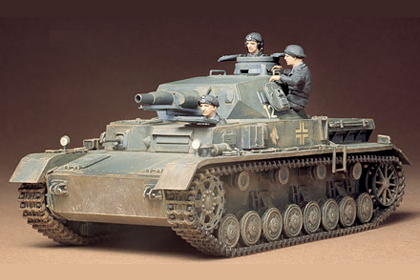
This is the Eduard, Big Ed (BIG 3513), photo etch set for the ‘German Panzerkampfwagen IV, Ausf. J‘ from Tamiya.
Detail set |
Tamiya |
||||
| (35 326) | Basic | ||||
| (35 547) | Zimmerit | 35 181 | |||
| (35 342) | Schürzen | ||||
| (XT 071) | Wheel mask | ||||
Source: Eduard
This is the Tamiya 35 205 kit in 1/35 scale, of the ‘German Infantry Equipment set B – Mid/Late’.
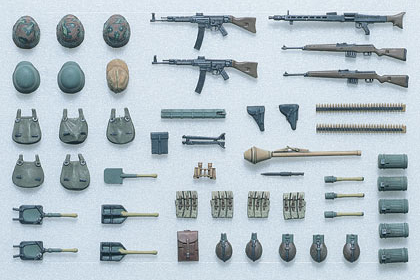
This is the Tamiya 35 204 kit in 1/35 scale, of the ‘German Infantry Equipment set A – Early/Mid’.
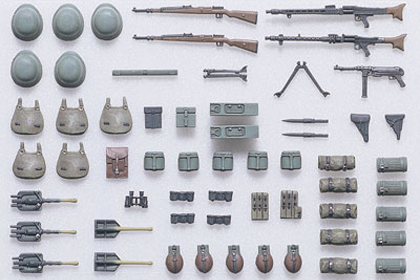
This is the Academy 13236 kit in 1/35 scale, of the ‘German Flakpanzer IV, Wirbelwind’.
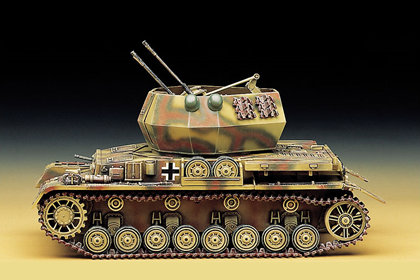
This is the Trumpeter 00209 kit in 1/35 scale, of the ‘German Mörser Karl-Gerat 040/041 on railway transport carrier’.

At a conference with Hitler in March 1943, it was stated that the first 54cm Gerät 041 would be delivered by June 1943, and the third, by mid-August. The 60cm and 54cm barrels appear to have been interchanged as required. In 1945, US forces captured vehicle II with a 60cm, and vehicle V with a 54cm. The prototype chassis, built in 1939, had eight road wheels with external swing arms. production Karl had eleven road wheels.
Ammunition was transported in a tracked Munitionsschlepper converted from the Pz.Kpfw.IV, four rounds in each Schlepper. For the 60cm Gerät 040, the s Be Granate weighed 2.117 tons and the Ie Be Granate, 1.70 tons; in this case of the 54cm Gerät 041, 1.58 tons and 1.25 tons respectively. Maximum rate of the fire was 6 rph (rounds per hour ). Guns I-IV went to the Russian Front in July 1941 with the 628th schwere Artillerie Abteilung.
They saw action at various sites, including Lemburg in that year. The best known action was against Sevastopol in 1942. Later, four guns were issued to the 833rd schwere Artillerie Abteilung (mot). These guns had the names Adam, Eve (1st Batt.) and Thor, Odin (2nd Batt.) The names for guns V and VI were Loki and Ziu.
This is the Tamiya 35 186-700 kit in 1/35 scale, of the ‘German Fuel Drum set’.

This is the Tamiya 35 291-3000 kit in 1/35 scale, of the ‘German 3 Ton 4×2 Cargo Truck’.
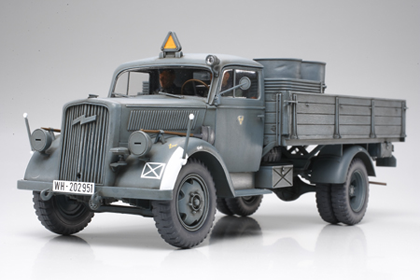
Ideal choice for German Army – The German army in WWII used a wide variety of wheeled vehicles as part of their overall strategy of fast mechanized warfare. Among the most widely used was the 3 ton 4×2 Cargo Truck, a truck design that was first produced in the 1930s. From 1937 to 1944, over 78,000 medium 3 ton 4×2 Cargo Trucks were produced and they became the most recognized German army truck in WWII.
Featuring a dependable 6-cylinder gasoline engine, the 3 ton 4×2 Cargo Truck could take on a very large payload disproportionate to its size. It also featured a durable rear wheel-drive chassis with superior off-road handling and a large cargo area, which enabled superb load-carrying capacity.
They proved to be not only extremely reliable, but also very versatile, and were employed in a wide variety of roles, including fuel truck, ambulance, radio truck, as well as general-purpose cargo truck and was until the end of war used to transport troops and supplies on all fronts.
This is the Trumpeter 00215 kit in 1/35 scale, of the ‘German Mörser Karl – Great 040/041’.
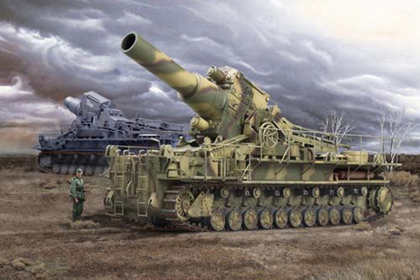
At a conference with Hitler in March 1943, it was stated that the first 54cm Gerat 041 would be delivered by June 1943, and the third, by mid-August. The 60cm and 54cm barrels appear to have been interchanged as required. In 1945, US forces captured vehicle II with a 60cm, and vehicle V with a 54cm. The prototype chassis, built in 1939, had eight road wheels with external swing arms. Production Karl had eleven road wheels.
Ammunition was transported in a tracked Munitionsschlepper converted from the Pz.Kpfw.IV, four rounds in each Schlepper. For the 60cm Gerat 040, the s Be Granate weighed 2.117 tons and the Ie Be Granate, 1.70 tons; in this case of the 54cm Gerat 041, 1.58 tons and 1.25 tons respectively. Maximum rate of the fire was 6 rph (rounds per hour). Guns I-IV went to the Russian Front in July 1941 with the 628th schwere Artillerie Abteilung. They saw action at various sites, including Lemburg in that year.
The best known action was against Sevastopol in 1942. Later, four guns were issued to the 833rd schwere Artillerie Abteilung (mot). These guns had the names Adam, Eve (1st Batt.) and Thor, Odin (2nd Batt.) The names for guns V and VI were Loki and Ziu.
This is the Trumpeter 01509 kit in 1/35 scale, of the ‘German Geschützwagen’.

The two halves of the train, before and behind the locomotive were identical and consisted of one artillery car with one 10cm le.F.H 14/19(p) gun, one command and infantry car and one artillery and anti-aircraft car with one 7.62cm F.K.295/l(r) and one 2cm anti-aircraft quadruple unit.
This is the Tamiya 35 096-1800 kit in 1/35 scale, of the ‘German Panzerkampfwagen IV, Ausf. D’.
